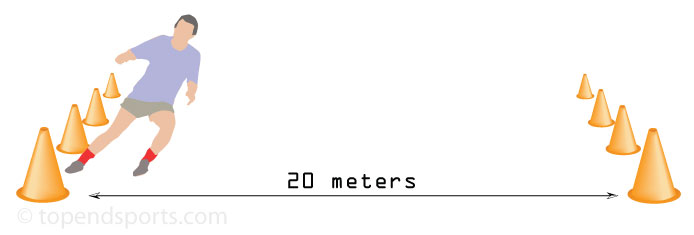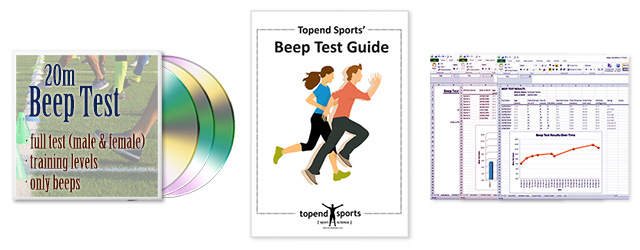The Aero test is a maximal aerobic test. It is a variation of the popular bleep/beep/multistage fitness test for measuring aerobic fitness. Participants run between two lines 20 meters apart in time to audio signals. For more information, see the complete guide to the beep test.
equipment required: Flat, non-slip surface, marking cones, 20m measuring tape, pre-recorded audio cd, cd player, recording sheets.
pre-test: Explain the test procedures to the subject. Perform screening of health risks and obtain informed consent. Prepare forms and record basic information such as age, height, body weight, gender, test conditions. Measure and mark out the course. Ensure that the participants are adequately warmed-up. See more details of pre-test procedures.
procedure: Use cones to mark out two lines 20 meters apart. The subject starts on or behind one of the lines, and begins running when instructed by the cd. This subject continues running between the two lines, turning when signaled by the recorded beeps. Each bleep is 0.05 km/hr quicker than the last one, and each 20 meters that is run counts as a score of one. If the line is not reached in time the subject must run to the line turn and try to catch up with the pace within 2 more ‘beeps’. The test is stopped if the subject fails to catch up with the pace within the two ends.
scoring: The athletes score is the total number of shuttles reached before they were unable to keep up with the recording. This score can be converted to a VO2max equivalent score using the following formula.
VO2max (ml/kg/min) = 5.73 x peak speed (km/hr) - 28.15 [Wilkinson et al. 1999)
target population: Suitable for sports teams and school groups, but not for populations in which a maximal exercise test would be contraindicated.
reliability: Reliability would depend on how strictly the test is run, and the practice allowed for the participants.
 advantages: Large groups can perform this test all
at once for minimal costs. Also, the test continues to maximum
effort unlike many other tests of endurance capacity.
advantages: Large groups can perform this test all
at once for minimal costs. Also, the test continues to maximum
effort unlike many other tests of endurance capacity.
disadvantages: Practice and motivation levels can influence the score attained, and the scoring can be subjective. As the test is usually conducted outside, the environmental conditions can be often affect the results. Norm values may be difficult to find, as it is more common to conduct the similar beep test.
other considerations: This test is a maximal test, which requires a reasonable level of fitness. It is not recommended for recreational athletes or people with health problems, injuries or low fitness levels.
references: Physiology Matters, David M Wilkinson (1999).
Similar Tests
Related Pages
- The complete guide to the beep test for links to more information.
- Beep test variations.
- Beep Test Software — provides the standard Multistage Fitness Test or Bleep Test right on your PC or Laptop, with many additional features.
BEEP TEST PACKAGE - only $10
The 20m Beep Test (male & female voices) + Training Levels + 'Beeps Only' track + Excel Spreadsheet + eBook Guide (PARQ, consent form, test recording sheet, warm-up, tips, norms + much more!)

The ultimate beep test package, including two versions of the beep test audio file (male and female voice), an audio track with only the beeps (no voices), 8 audio tracks for training at specific test levels, an Excel spreadsheet with an offline calculator and tables for recording, analyzing and presenting results, a 12-page eBook beep test guide which includes a PARQ, informed consent form, and test recording sheet plus much more. All these files are available individually for $5 each, or even better get them all for $10. Check out the details.


 Current Events
Current Events